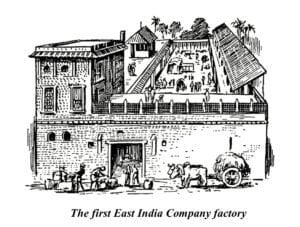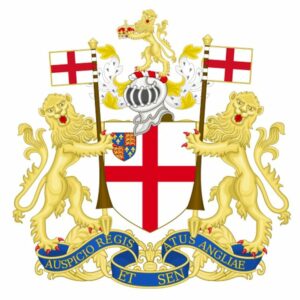It was the East India Company.
What was it?
It was a company that was so powerful that it effected the global balance of trade, moving between the east and the west. This was because by the mid-1700s it appeared to have become involved in half the world’s trade.
This British company, was part owned by Government and was so big that it had its own army of 260,000 soldiers, twice that of the British Army!
Sir Francis Drake and the Armada?
Yes, Francis Drake started it all. You see when he returned from the first trip round the world in 1580, he bought home with him a huge haul of treasure. This he had got by bartering the goods he had stolen on his trip with local Sultans for a variety of spices. The City merchants who invested in his venture are thought to have made a profit of over 5000%!
This was followed by the Spanish Armada, where we learnt from captured Spanish ships that they had much bigger holds. This intelligence allowed us to build bigger ships, one of the benefits of the Armada we aren’t usually told about.
What happened next?
The large profits that could be made led to the City merchants petitioning to the Queen for permission to sail to the Indian Ocean. They wanted to break the Spanish and Portuguese monopoly of Far Eastern Trade.
In 1591 Elizabeth granted permission, then on 10 April 1591 three ships sailed from Torbay on the first successful English expedition to India. They didn’t return until May 1594, but on their return, they proved a point with the successful goods with which they returned.
The Creation of the Royal Charter
In 1599, the City merchants decided to apply for a Royal Charter to allow them to undertake trade with the East Indies. To fund the venture they committed £30,133, which is £4M in today’s money. Their original application failed, but they weren’t put off and decided to double their investment and buy some ships.
Finally, on 31 December 1600, the Queen, responded favourably to their petition and granted her charter. It was under the name of The Governor and Company of Merchants of London trading into the East Indies. They got more than that, they got a monopoly for fifteen years for English trade with all countries east of the Cape of Good Hope and west of the Straits of Magellan.
A point of interest, then, as was traditional, the company’s business was carried out from The Nags Head Inn in Bishopsgate, a pub!
Early voyages to the East Indies
The first of the companies ships The Red Dragon left in 1601 under the command of Sir James Lancaster and on a successful trip set up the first two of the companies “Factories”.
This voyage was the start of many more, with many more “Factories” set up.
What were Factories?
Basically, even though they were called “factories”, they were really an early version of free trade areas where the local inhabitants could trade freely with foreign merchants,
 The interesting thing is that a “factory” actually served many differing purposes all at the same time, it was a:
The interesting thing is that a “factory” actually served many differing purposes all at the same time, it was a:
• market, its initial purpose
• warehouse, logically to store goods
• customs office, to record everything coming in and going out
• defence, from the locals
• support for further explorations
• headquarters or de facto government of local communities.
What happened as it grew?
Eventually it grew to control large chunks of India, using its military might to retain its profits and by doing this assumed administrative operation.
This meant that by 1757 the Company ruled most of the continent of India until as a result of the Indian Rebellion of 1857, the British government took over direct control of India, which led to the description of the British Raj.
Therefore, we should be proud that 300 years ago a single company controlled half the world’s trade and it was a British company!
Isn’t history fun?
10 questions to discuss:
- What impact did the East India Company have on the global balance of trade by the mid-1700s, and how did it achieve such influence?
- Who was Sir Francis Drake, and what role did he play in the establishment of the East India Company?
- How did the intelligence gained from captured Spanish ships during the Spanish Armada contribute to the development of England’s maritime capabilities?
- Describe the events leading up to the first successful English expedition to India in 1591.
- What prompted the City merchants to seek a Royal Charter for trade with the East Indies, and how did they finance their venture?
- When was the Royal Charter granted to the East India Company, and what privileges did it confer upon the company?
- Where was the East India Company’s business initially conducted, and what is the significance of this location?
- Who commanded the first voyage of the East India Company’s ship, The Red Dragon, and what was the outcome of this expedition?
- What were “Factories” in the context of the East India Company’s operations, and what functions did they serve?
- How did the East India Company expand its influence beyond trade to control significant portions of India, and what were the eventual consequences of its rule?
More information:
https://southasia.ucla.edu/history-politics/british-india/east-india-company/
© Tony Dalton
Lorem ipsum dolor sit amet, consectetur adipiscing elit. Ut elit tellus, luctus nec ullamcorper mattis, pulvinar dapibus leo.


